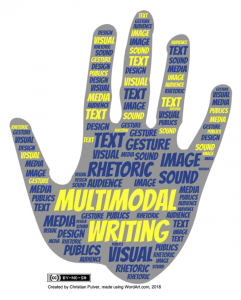8 Visual Rhetoric
Dahliani Reynolds, PhD

We live in a world saturated with images: from the images we see driving down the street (traffic signs, billboards, crosswalks), to the images we see on our screens (advertisements, memes, Kardashians), they all impart meaning. You might not have thought about it before, but something as simple as a stop sign is an example of visual rhetoric. The visual cue of the red octagon at the end of the street tells you to stop, even before you read the letters. While visual rhetoric may or may not be a familiar term for you, you are already a proficient visual rhetorician, simply through your daily life: you encounter and interpret visual information all the time.

We tend to think of rhetoric as oral or written text. In other words, well, words. Writing is traditionally understood as alphabetic text—putting letters into words into sentences into paragraphs into pages. In recent years, however, with the rise of digital media and the internet, many writing studies, rhetoric, and composition scholars have worked to redefine and expand our understanding of writing to include a variety of modalities—common ways of communicating beyond alphabetic text, that include visual, audio, and digital modes of writing. Integrating two or more modalities in a given text results in multimodal writing.
Visual rhetoric is a form of rhetoric that uses visual information—photographs, drawings, symbols, charts, maps, color, shapes, typography, white space—to communicate, to create meaning, or, more simply, to persuade (see chapter on rhetoric for a longer discussion). This visual information might be used independently, as in the stop sign example from the prior paragraph. The stop sign works alone to communicate its purpose; you don’t need additional information to correctly interpret the meaning. But you can also use visual images in combination with other visuals, or with other modes, to achieve your purpose. For example, an editorial cartoon might use a drawing and speech bubbles to effectively communicate its message. Or you might set a musical background to a photo essay to communicate a particular mood or tone to an audience. Regardless, whether you use a single visual image, multiple images, or integrate visual and textual information, the visual elements work together to create meaning.
It’s important to keep in mind that visuals are culturally dependent. This means that some visual information may be interpreted differently across cultures. Take, for example, the color white. A white dress in western cultures signifies bridal attire; in some Asian cultures, however, white is typically worn at funerals (a clothing color we would almost never see at funerals in the United States). Likewise, some casual hand gestures in the U.S., such as an okay sign, or a thumb’s up, have obscene connotations in other parts of the world. Awareness of how visual information might translate across multicultural audiences is essential for professional and public writers targeting global audiences.
Visual rhetoric is useful in many genres, particularly when we think expansively about the kinds of visual elements we might use. Professional writing might make limited use of photographs, but using white space, typography, and color helps create an appropriate ethos and strong visual design to guide and persuade readers. Writing for public audiences often uses a variety of visual elements, including photographs, charts, graphs, and maps to convey information or draw on pathos to connect with readers.
Media Attributions
- Stop_sign is licensed under a Public Domain license
- MultimodalHand © Christian Pulver is licensed under a CC BY-NC-SA (Attribution NonCommercial ShareAlike) license

